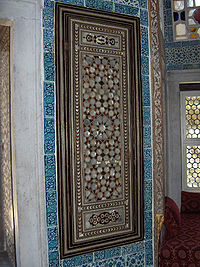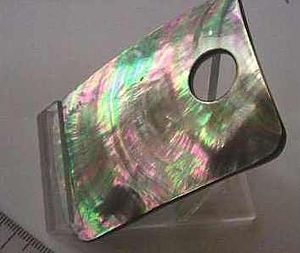AY Honors/Shells - Advanced/Answer Key
Template:Sea shell topics Template:Redirect Nacre, also known as mother of pearl, is an organic-inorganic composite material produced by some mollusks as an inner shell layer. It is exceptionally strong, resilient, and iridescent. Nacre is found in some bivalves, some gastropods and some cephalopods. The inner shell layer in most mollusks however is merely porcellaneous, in other words shiny like a china plate, not iridescent.
Pearls and the inside layer of the pearl oyster shells and the freshwater pearl mussel shells are made of nacre. Many other families of mollusks also have an inner shell layer which is nacreous, including gastropods such as the Haliotidae, the Trochidae and the Turbinidae.
Description

Nacre is composed of hexagonal platelets of aragonite (calcium carbonate (CaCO3) crystals) 10-20 µm wide and 0.5 µm thick, arranged in a continuous parallel lamina. These layers are separated by sheets of organic matrix composed of elastic biopolymers (such as chitin, lustrin and silk-like proteins). This mixture of brittle platelets and the thin layers of elastic biopolymers makes the material strong and resilient. Strength and resilience are also likely to be due to adhesion by the "brickwork" arrangement of the platelets, which inhibits transverse crack propagation. This design at multiple-length sizes increases its toughness enormously, making it almost equivalent to that of silicon.
Nacre appears iridescent because the thickness of the aragonite platelets is comparable to the wavelength of visible light. This results in constructive and destructive interference of different wavelengths of light, resulting in different colors of light being reflected at different viewing angles.
Nacre is secreted by the epithelial cells of the mantle tissue of some species of mollusk. The nacre is deposited onto the inner surface of the shell, the iridescent nacreous layer, commonly known as mother of pearl. This smooths the shell and defends against parasites and damaging detritus by entombing them in successive layers of nacre, forming a pearl. The process is called is encystation and continues while the mollusk lives.
Chief sources are the pearl oyster, found in warm and tropical seas, primarily in Asia; freshwater pearl mussels, which live in many rivers of the United States, Europe, and Asia; and the abalone of California, Japan, and other Pacific regions.
Decorative uses

Mother of pearl has been used over many centuries for all kinds of decorative purposes.
Both black and white mother of pearl are used for architectural purposes. The natural mother of pearl may be artificially tinted to almost any color. Mother of pearl tesserae may be cut into shapes and laminated to a ceramic tile or marble base. The tesserae are hand-placed and closely sandwiched together, creating an irregular mosaic or pattern (such as a weave). The laminated material is typically 1/16 of an inch thick. The tesserae are then lacquered and polished creating a durable, glossy hard surface.
Instead of using a marble or tile base, the mother of pearl tesserae can be glued to a fiberglass mesh. The result is a lightweight material that offers a seamless installation, and there is no limit to the sheet size. Mother of pearl sheets may be used on interior floors, exterior and interior walls, countertops, doors and ceilings. Insertion into architectural elements, such as columns or furniture is easily accomplished.
Clothes & accessories
Mother of pearl buttons can be found on a variety of clothing such as shirts, skirts and coats. Nacre is also used as a decorative feature of watch faces, knives, guns and jewelry.
Musical instruments
Key touches and various decorations on musical instruments such as saxophones, trumpets, violins, banjos, tamburitzas and guitars are sometimes made of mother of pearl. It is used as inlays on many guitar fretboards.
Synthetic key touches made of Pyralin or similar imitation nacre materials have been affectionately referred to as mother of toilet seat by musicians.
References
See also
Template:Commonscat Template:Wiktionary
bg:Седеф da:Perlemor de:Perlmutt es:Nácar eo:Perlamoto fr:Nacre it:Madreperla he:אם הפנינה lt:Perlamutras mn:Тана nl:Parelmoer no:Perlemor pl:Masa perłowa pt:Madrepérola ru:Перламутр sv:Pärlemor vi:Xà cừ (vật liệu) tl:Binga


